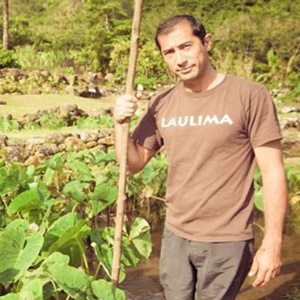Winter recognized by National Wildlife Federation
 UH Mānoa alumnus Dr. Kawika Winter (Mānoa, BA ’01; MS ’04; PhD ’13) has been recognized as one of “The Ecoleaders Top 50 Inspirations” by the National Wildlife Federation (NWF). The Ecoleaders Top 50 Inspirations is a group of change-makers and rising stars who are making a difference in the sustainability movement.
UH Mānoa alumnus Dr. Kawika Winter (Mānoa, BA ’01; MS ’04; PhD ’13) has been recognized as one of “The Ecoleaders Top 50 Inspirations” by the National Wildlife Federation (NWF). The Ecoleaders Top 50 Inspirations is a group of change-makers and rising stars who are making a difference in the sustainability movement.
As an NWF Fellow, Winter focused on developing a natural resource management system for the Limahuli Garden and Preserve, which is a part of the National Tropical Botanical Gardens. Today, Kawika is the director of Limahuli. David Corsar of NWF sat down with Kawika for an interview.
David Corsar: Looking back at your experience with NWF, how has participation as an NWF Fellow help shape your career path?
Kawika Winter: As an NWF Fellow I have tapped into a network of conservation professionals around the country which I would not have access to otherwise. Professional networks, such as these, are absolutely essential to seeking out new collaborators and creating the synergy needed for conservation efforts to make a real and lasting impact.
DC: What was the top thing that you learned in your professional development with NWF?
KW: My NWF Fellowship occurred right at the cusp of my academic and professional careers which was a very formative time for me. The Fellows trip to Washington, DC, which was my first time there, truly opened my eye to the importance of influencing national policy. It helped to put me on a trajectory of engaging with policy makers in my own state, which has been a fruitful use of my time and energy. Inspiring and influencing the perspectives of policy makers is one of the most effective ways of making strides in conservation.
DC: What are you up to these days? What is your role at the National Tropical Botanical Garden, and why did you choose to work there?
KW: The NTBG is a congressionally-chartered, non-profit organization with a mission to enrich life by perpetuating the survival of plants, ecosystems and cultural knowledge of tropical regions. This multi-site organization has five botanical gardens and nature preserves between Hawai‘i and Florida. I am the director of Limahuli Garden and Preserve, the largest of NTBG’s sites which is housed in a one-thousand acre valley in the most biodiverse corner of the most biodiverse island in the biodiversity hot spot that is the Hawaiian archipelago. You could say that we are the hot spot of the hot spot of the hot spot in the State that is both the endangered species capital and extinction capital of the United States. We have dozens of species of plants and birds that are critically endangered. On top of that our valley is filled with storied and sacred places of the Hawaiian people. My job is to harness the synergy which comes from bringing the world of science and conservation together with the world of ancestral practice and philosophy, and to direct that energy towards being a model of biocultural conservation in Hawai‘i. I often liken my job to that of a symphony conductor. As I administer over our conservation, research, education, visitor, and community-outreach programs I need to make sure that everyone is playing in time from the same sheet of music. The music that we make is certainly beautiful, and I hope that you will get to come to Hawai‘i some time to hear it.
DC: I sure hope so too! What would you say is your personal mission for sustainability?
KW: I actually believe that aiming towards sustainability is setting our sights too low. I realize that much of the world views human interaction with the natural world as a zero-sum game; and, therefore, the best we could ever hope for is “sustainability” where our extractions equal our inputs. I, however, subscribe to a different world view. I live with traditions and examples of how human interaction with the natural world can increase biodiversity and resource abundance. To me, “sustainability” is where the pendulum rests if it were not in motion. What I have dedicated my career to is getting people to embrace the idea that we can indeed swing the pendulum in the other direction towards perpetual abundance, and providing a model of how we can get there.
For the full interview, click here.
